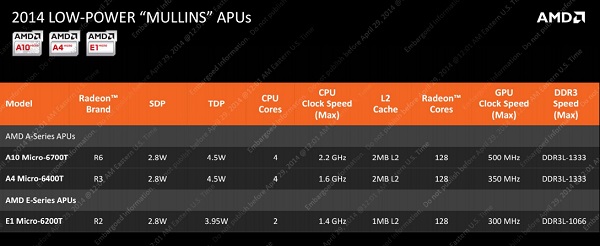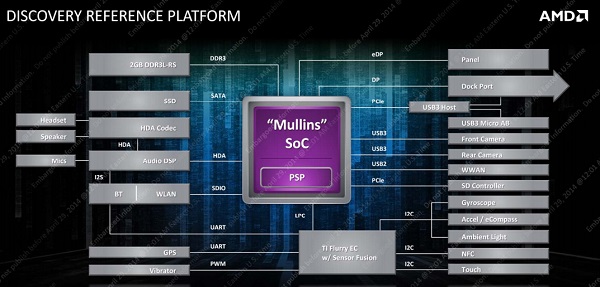AMD has not had much luck in tablets, that’s no secret and Intel hasn’t exactly done a great job, either. For years mass-market tablets were powered solely by ARM-based chips, but last year Intel upped the ante with Bay Trail-T, arguably the first truly competitive x86 SoC in the tablet space.
This year it’s AMD’s turn. Mullins offers a big improvement over Temash, it delivers a lot more performance and a few new features that make it a lot more attractive than its predecessor. Performance is not an issue, either.
However, having a good product simply isn’t enough.
Why Mullins could succeed where other APUs have failed
Mullins offers vastly superior efficiency compared to Temash. AMD started using the SDP metric last year, in response to Intel’s decision to use SDP for some of its mobile/tablet parts. However, AMD still uses TDP, too.
Mullins parts feature an SDP of 2.8W. AMD previously stated that Mullins would end up with an SDP of ~2W, roughly on a par with Bay Trail-T parts. The actual TDP is of course somewhat higher. Temash parts feature an SDP of 3W to 4W, but the TDP is about 8W. Mullins offers a huge improvement, with an SDP of 2.8W and TDP ranging from 3.95W to 4.5W. Thanks to STAMP and other efficiency tweaks, Mullins can deliver quite a bit more performance than Temash in the same thermal envelope, and then some.

For example, the Temash based A6-1450 packs four Jaguar CPU cores clocked at 1GHz and it can hit 1.4GHz on Turbo. The GPU is clocked at 300MHz, but it clock up to 400MHz on Turbo. However, the Mullins-based A10 Micro-6700T can hit a max CPU clock speed of 2.2GHz, while the GPU can reach 500MHz. This is not only much higher than what Temash was capable of, it is also higher than what we saw on mainstream Kabini APUs with a TDP of 15W, yet the A10 Micro-6700T is a 4.5W part.
'Contra revenue' is Intel’s biggest competitive advantage
AMD has been showing off its Discovery tablet platform for a while, but so far AMD-based tablets have been scarcer than hen’s teeth. Now that AMD finally has a truly competitive part that can take on Bay Trail-T, it would be logical to expect more design wins.
However, thanks to Intel’s ‘contra revenue’ scheme this won’t be easy. Intel insists it’s not doing anything wrong and it doesn’t like it when someone describes its tablet push as a massive subsidy programme. Ultimately, that’s what it really is. Just because Mullins could succeed doesn't mean it actually will.

AMD is not thrilled by the prospect of more Intel subsidies and market development programmes. The company has been dealing with similar Intel shenanigans for almost two decades and it knows it cannot compete on a level playing field. AMD cannot afford to burn hundreds of millions of dollars per quarter to gain a few dozen tablet design wins. Therefore AMD is targeting a somewhat different market, mid-range $299 tablets. Intel is trying to grab everything from $99 to $299 with its tablet SoCs, while Haswell and Broadwell should take care of the higher end of the market.
Intel hopes to ship 40 million tablet parts this year. We don’t know what AMD has in mind, but it is probably not even close to 40 million. It will be tricky, but this time around AMD appears to have a truly competitive product. In addition, not even Intel can afford to keep spending $1bn per year on its tablet push, so we should see its contra revenue taper off moving forward.
Even so, it might give Intel a huge competitive advantage. Intel is on track to quadruple its tablet shipments this year. If it manages to double them next year it will end up with 80+ million units, which seems like a relatively conservative estimate at this point. Intel is stealing design wins from the likes of Mediatek, Rockchip, Nvidia and so on. AMD will have to steal them back from Intel, which sounds a bit more difficult, even with competitive products.




